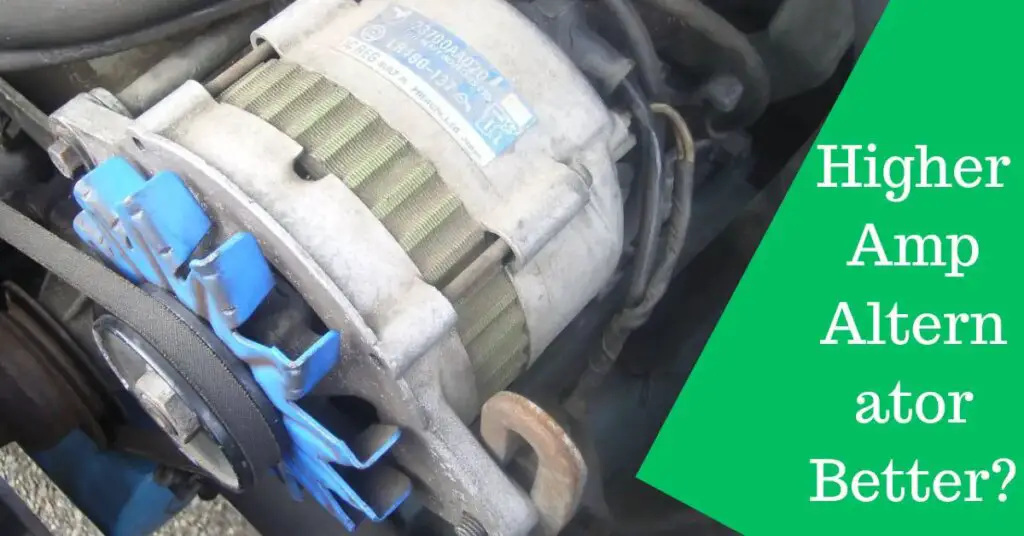It is a common misconception that the higher the amp alternator, the better. It can be misleading to just look at this number and assume it is more powerful than one with lower amperage. This article will cover everything you need to know about the amp of alternators in order to make an informed decision between two different models.
While vehicles are equipped with an array of electrical features and accessories, the importance of a reliable and efficient alternator cannot be overstated. This article aims to explore the question, “Is a higher amp alternator better?” by delving into the role of amperage in alternators and the benefits it offers.
Whether you’re considering an alternator upgrade or seeking a better understanding of automotive electrical systems, this article will provide valuable insights.
Table of Contents
What Is An Automotive Alternator?
An automotive alternator is a device found in most modern vehicles that generates electrical power. It is an essential component of the vehicle’s charging system. The primary function of an alternator is to convert mechanical energy into electrical energy, which powers the electrical systems and charges the battery while the engine is running.
The alternator consists of several key components: a rotor, stator, diode rectifier, voltage regulator, and pulley. The rotor is a rotating assembly that contains a coil of wire called the field winding.
On the other hand, the stator is a stationary component surrounding the rotor and consists of multiple coils of wire called the stator windings. The interaction between the magnetic field created by the rotor and the stator windings induces an alternating current (AC) voltage in the stator windings.
The AC voltage produced by the alternator is then converted into direct current (DC) by the diode rectifier. The rectifier is a set of diodes that allow current flow in only one direction, ensuring that the electrical output from the alternator is in the form of DC.
The voltage regulator controls the alternator’s output voltage, keeping it within the desired range and preventing overcharging of the battery.
The alternator is driven by a belt connected to the engine’s crankshaft pulley. As the engine runs, the mechanical energy from the engine’s rotation is transmitted to the alternator, causing the rotor to spin and generate electricity.
The alternator provides electrical power to the vehicle’s electrical systems, such as lights, ignition system, audio system, and other components. It also recharges the battery, ensuring that it remains charged and ready to start the engine the next time it is needed.
The automotive alternator plays a crucial role in powering a vehicle’s electrical systems and maintaining the battery’s charge, allowing for the reliable operation of various electrical components while the engine is running.
What is Alternator Amperage?
Alternator amperage refers to the maximum amount of electrical current that an alternator can produce or supply to the vehicle’s electrical system. It is commonly expressed in amperes (A) and represents the alternator’s capacity to deliver electrical power.
The alternator amperage rating is typically specified by the manufacturer and can vary depending on the vehicle’s make, model, and electrical system requirements.
Higher amperage alternators are often found in vehicles with increased electrical demands, such as those equipped with additional accessories, high-powered audio systems, or specialized equipment.
Alternator amperage is measured by connecting an ammeter in series with the alternator’s output circuit. The ammeter measures the flow of electrical current in amperes. This measurement provides an indication of the alternator’s output capacity and helps determine if it is operating within its specified range.
It’s important to note that the alternator’s amperage rating represents its maximum output capacity, and the actual current drawn by the vehicle’s electrical system will depend on the electrical load or demand at any given time.
The alternator will supply the required current to power the electrical components and charge the battery as needed. If the electrical load exceeds the alternator’s capacity, the battery may be used to supply additional power, leading to a gradual depletion of its charge.
The relationship between amperage and power output can be understood using the equation: Power (in watts) = Voltage (in volts) × Current (in amperes). Since alternators produce electrical power, the output power can be calculated by multiplying the alternator’s output voltage (typically around 12 to 14 volts) by the amperage it delivers. Therefore, a higher amperage alternator will have a greater potential to produce more electrical power.
It’s worth mentioning that while the alternator’s amperage rating is important, it is also crucial to consider the overall electrical system’s capacity, including the wiring, connectors, and other components, to ensure they can handle the increased current flow without overheating or becoming overloaded.
Alternator amperage represents the maximum current output capacity of the alternator. Measured using an ammeter, it indicates the flow of electrical current. Understanding the relationship between amperage and power output helps determine the alternator’s ability to supply electrical power to the vehicle’s electrical system.
The Role of Amperage in Alternators
Electrical Power Generation
The primary purpose of an alternator is to generate electrical power. The alternator’s amperage rating determines the maximum amount of current it can produce. A higher amperage rating means the alternator is capable of supplying more electrical power to meet the demands of the vehicle’s electrical system.
Charging the Battery
One of the critical functions of an alternator is to charge the vehicle’s battery. The amperage output of the alternator determines how quickly it can replenish the battery’s charge. A higher amperage alternator can recharge the battery more rapidly.
Powering Electrical Loads
The amperage rating of the alternator also influences its ability to power various electrical loads in the vehicle. Electrical components such as lights, audio systems, heating and cooling systems, and other accessories require a certain amount of current to operate. An alternator with a higher amperage rating can supply more power to support these electrical loads simultaneously.
Load Handling
The amperage rating of the alternator is closely related to its ability to handle heavy electrical loads without being overloaded. If the electrical demand exceeds the alternator’s capacity, it may struggle to supply enough current, resulting in reduced performance of electrical components or even a discharged battery.
Choosing an alternator with an appropriate amperage rating ensures it can handle the expected electrical loads without being strained.
Upgraded Electrical Systems
In certain cases, vehicle owners may choose to upgrade their electrical systems by adding more accessories or higher-powered components. This increased electrical demand may require a higher amperage alternator to provide sufficient power. Upgrading to an alternator with a higher amperage rating ensures the electrical system can operate effectively under the increased load.
It’s important to note that while amperage is a crucial factor, it should be considered in conjunction with other electrical systems components, such as wiring and connectors, to ensure they can handle the increased current flow without overheating or becoming a bottleneck.
The amperage rating of an alternator directly affects its power-generating capacity, ability to charge the battery, power electrical loads, and handle various electrical demands. Choosing an alternator with an appropriate amperage rating is essential for the proper functioning of the vehicle’s electrical system.
Benefits of a Higher Amp Alternator
Improved Electrical Performance
A higher amp alternator can provide a greater amount of electrical power to the vehicle’s electrical system. This results in improved performance and reliability of electrical components, such as brighter headlights, stronger audio output, and faster operation of power windows and other accessories. It helps prevent voltage drops and ensures consistent power delivery even under heavy electrical loads.
Meeting Increased Power Demands
If you have added aftermarket accessories or components that demand more power, such as high-powered audio systems, additional lighting, or specialized equipment, a higher amp alternator can meet these increased power demands. It ensures that the electrical system has sufficient capacity to handle the added load without overloading the alternator or draining the battery.
Enhanced Charging Capabilities
A higher amp alternator can charge the vehicle’s battery more efficiently and quickly. It is particularly beneficial when the electrical system is under heavy use, or the battery is regularly drained due to extended periods of engine idling, frequent short trips, or power-hungry accessories.
The higher amp alternator ensures that the battery remains charged, reducing the risk of battery-related issues and providing reliable starting power.
Compatibility with Upgraded Electrical Systems
If you have upgraded your vehicle’s electrical system by adding more accessories or higher-powered components, a higher amp alternator is often necessary.
These upgrades increase the electrical load, and a higher amp alternator ensures that the system has enough power to operate all the added components without straining the alternator or causing voltage drops. It helps maintain system stability and prevents issues like dimming lights or blown fuses.
It’s important to consider that while a higher amp alternator offers benefits, it should be matched with the vehicle’s electrical system requirements and other components.
Upgrading the alternator alone may not solve underlying issues caused by insufficient wiring, connectors, or grounding. Proper installation and compatibility with the overall electrical system are essential for optimal performance and reliability.
A higher amp alternator provides improved electrical performance, meets increased power demands, enhances charging capabilities, and ensures compatibility with upgraded electrical systems, offering a more reliable and efficient operation of the vehicle’s electrical components.
The Supply & Demand of the Amp Alternator
The amp rating on an alternator is important because it dictates the power output. The higher the amp rating, the more powerful it will be and vice versa for lower amperage ratings.
For example, if your car runs with lights on and needs to draw 80A, then your 400A alternator will produce only 80A. So, what’s the difference between a 100A alternator and 400A alternator in this case?
Alternators are not rated by amps at all but rather amperes per hour (A/H).
- If you’re running a stock vehicle, chances are an alternator with about 60 to 80A/H is enough for your needs. If you have aftermarket audio equipment installed in the car or haul around multiple power-hungry gadgets and accessories then you may want to go up to 110-120A/H
How the current works is that it starts at the battery and then travels through a wire to an electrical component. The higher-amp alternator will produce more volts than the lower-amp one, so when there are multiple components drawing power from the same source (wire), they all have enough voltage. If you’re running with only lights on, your 100A alternator would be more than enough.
The amperage works based on supply and demand, so the alternator supplies as many amps as the vehicle needs.
How many Amps do You Need?
If you want to calculate how many amps your alternator should be, use this formula:
(amp-draw of the component) / (.05A) x 20 = amperage
Here are some components that suck up large amperage:
- Air conditioner: 20A
- Audio Amplifiers: up to 70A
- High Beam Head Light: 15A
- Power Windows: up to 30A
In case you want to upgrade your car with aftermarket equipment, you should be aware of the amp that it draws. Use the formula above to help you with the calculation.
How to increase alternator output amperage?
In case you want to increase the alternator output amperage without buying a new one, here are what you can try:
- To generate a higher amperage, it’s best to use thicker wire in the stator windings. That way, you can get more current by reducing winding impedance and providing enough flux to energize the windings.
- Upgrade your alternator with a positive grounding system. This will allow for even more amperage to be provided by upgrading the voltage regulator in order for it to have a higher output;
- Add another rotor and stator assembly. These are like two sets of rotors stacked on top of each other, which creates an additional 30A
Considerations When Upgrading to a Higher Amp Alternator
1. Vehicle Compatibility
Ensure the higher amp alternator is compatible with your vehicle make, model, and engine type. Different vehicles have varying electrical system requirements and mounting configurations, so it’s important to choose an alternator that fits properly and can be installed without major modifications.
2. Electrical System Modifications
Upgrading to a higher amp alternator may require modifications to your vehicle’s electrical system. This includes upgrading the wiring, connectors, and possibly the battery cables to handle the increased current flow.
It’s crucial to assess the entire electrical system and make any necessary modifications to ensure proper functionality and prevent electrical issues.
3. Potential Impact on the Battery
A higher amp alternator can supply more current to charge the battery efficiently. However, it’s important to ensure that the battery is capable of handling the increased charging rate.
Consider upgrading to a battery with a higher capacity and Cold Cranking Amps (CCA) rating to match the increased power output of the alternator.
4. Professional Installation and Expert Advice
Upgrading to a higher amp alternator can be a complex task, especially if modifications to the electrical system are required. It is recommended to have the installation performed by a professional who has experience with automotive electrical systems. They can ensure proper installation, address any compatibility issues, and provide expert advice on selecting the right alternator for your specific needs.
Consulting with experts, such as automotive technicians or electrical specialists, can be beneficial in determining the appropriate alternator upgrade for your vehicle. They can assess your electrical system, recommend suitable options, and guide you through installation.
It’s essential to prioritize safety, reliability, and compatibility when upgrading to a higher amp alternator to ensure optimal performance and avoid potential electrical problems.
Factors Influencing Alternator Amperage Selection
1. Power Requirements
Consider the power demands of your vehicle’s electrical system. Evaluate the total power consumption of all electrical components, including the factory-installed systems and any aftermarket accessories or upgrades. This assessment will help determine the minimum amperage required to meet the existing power requirements.
2. Electrical Accessories and Upgrades
If you have added or plan to add electrical accessories or upgrades to your vehicle, such as high-powered audio systems, auxiliary lighting, or other power-hungry devices, you’ll need to account for their power consumption.
These additions increase the overall electrical load, and the alternator must be capable of supplying enough amperage to accommodate the increased demand.
3. Future Expansion and Modifications
Consider any potential future expansion or modifications to your vehicle’s electrical system. If you anticipate adding more accessories or upgrades down the line, it may be wise to select an alternator with a slightly higher amperage than your current requirements. This allows for future growth without needing to upgrade the alternator again.
4. Battery Capacity
Assess the capacity and condition of your vehicle’s battery. Ensure that the alternator’s amperage is suitable for efficiently charging the battery. A higher amperage alternator can recharge the battery more rapidly, particularly if you frequently use power-hungry accessories or engage in activities that drain the battery.
5. OEM Recommendations and Vehicle Specifications
Check the manufacturer’s recommendations for your specific vehicle model. OEM guidelines can provide insights into your vehicle’s appropriate alternator amperage range. Review your vehicle’s specifications and consult the owner’s manual for any specific requirements or limitations related to the alternator.
Remember that the alternator’s amperage rating should be balanced with the capacity of other components in the electrical system, such as wiring, connectors, and the battery. It’s important to ensure that the entire system can handle the increased current flow without overheating or experiencing voltage drops.
Selecting the appropriate alternator amperage involves considering the existing power requirements, and potential future upgrades and ensuring compatibility with the vehicle’s electrical system for optimal performance and reliability.
Frequently Asked Questions
Is it OK to get a higher amp alternator?
Yes, getting a higher amp alternator is generally okay as long as it is compatible with your vehicle’s electrical system. However, it’s important to consider the power requirements of your vehicle and any aftermarket accessories or upgrades.
Upgrading to a higher amp alternator can provide benefits such as improved electrical performance, meeting increased power demands, enhanced charging capabilities, and compatibility with upgraded electrical systems.
How many amps is a good alternator?
The amperage rating considered “good” for an alternator depends on the specific vehicle’s electrical system requirements and power demands. Typically, most passenger vehicles come equipped with alternators ranging from 90 to 150 amps.
However, vehicles with higher power demands, such as those with heavy-duty accessories or specialized equipment, may require alternators with 200 amps or higher amperage ratings.
It is recommended to consult your vehicle’s specifications and consider your power requirements when determining the appropriate amperage for a good alternator.
What are the pros and cons of a high amp alternator?
Pros:
- Increased electrical power output, providing improved performance for electrical components.
- Ability to meet increased power demands from accessories or upgrades.
- Enhanced charging capabilities, allowing for faster battery recharge.
- Compatibility with upgraded electrical systems.
- Potential for future expansion or modifications without needing to upgrade the alternator again.
Cons
- Costlier than lower amp alternators.
- May require modifications to the electrical system, including wiring and connectors.
- Higher amperage may put strain on other electrical components if they are not properly upgraded.
- Increased current flow can generate more heat, necessitating adequate cooling measures.
- Can potentially lead to battery drain if power demand is consistently low.
What does a 220 amp alternator do?
A 220 amp alternator has a high amperage rating and can provide substantial electrical power. It is typically used in vehicles with significant power requirements or those equipped with extensive aftermarket accessories or upgrades.
A 220 amp alternator offers increased electrical output, allowing for improved performance and reliability of electrical components, meeting higher power demands, and efficient charging of the battery.
This higher amperage rating can support power-hungry systems, such as advanced audio setups, auxiliary lighting, or other high-power accessories.
Can I install a higher amp alternator without upgrading my vehicle’s electrical system?
While it is possible to install a higher amp alternator without upgrading the vehicle’s electrical system, it is not recommended. A higher amp alternator generates more current, which puts increased strain on the wiring, connectors, and other components.
Upgrading the electrical system, including wiring and connectors, ensures they can handle the increased current flow and prevents overheating or voltage drops. It is best to consult with an expert or technician to determine the necessary electrical system upgrades when installing a higher amp alternator.
How does a higher amp alternator affect fuel economy?
A higher amp alternator itself does not directly affect fuel economy. However, suppose the higher amp alternator is constantly operating at a higher output to meet increased power demands.
In that case, it may draw more power from the engine, which can lead to slightly decreased fuel economy. The impact on fuel economy is generally minimal, but it’s important to ensure that the alternator’s output matches the vehicle’s power requirements to avoid unnecessary energy consumption.
What are the signs of a failing alternator?
Signs of a failing alternator may include dim or flickering lights, a dead or weak battery, difficulty starting the vehicle, strange noises (such as grinding or whining), electrical system malfunctions, or the appearance of warning lights on the dashboard.
Can a high amp alternator damage the electrical components in my vehicle?
A high amp alternator, if properly installed and compatible with the electrical system, should not damage the electrical components in your vehicle. However, ensuring that the wiring, connectors, and other electrical components can handle the increased current flow is important.
If these components are not adequately upgraded, they may become overloaded and prone to overheating or failure. Proper installation and matching the alternator’s amperage with the vehicle’s electrical system requirements are crucial to prevent potential damage to the electrical components.
How long does an alternator typically last?
The lifespan of an alternator can vary depending on several factors, including the quality of the component, driving conditions, and maintenance. On average, alternators can last between 100,000 to 150,000 miles (160,000 to 240,000 kilometers).
However, it’s important to note that alternators can fail prematurely for various reasons, such as excessive electrical loads, poor maintenance, or manufacturing defects. Regular maintenance, such as checking the belt tension and electrical connections, can help prolong the lifespan of the alternator.
Can I replace my alternator myself, or should I seek professional help?
Replacing an alternator can be a complex task, and it is generally recommended to seek professional help unless you have experience and knowledge in automotive electrical systems. Proper installation is crucial to ensure compatibility, proper wiring, and correct belt tension.
Additionally, professional technicians have the tools and expertise to diagnose any underlying electrical system issues and ensure the new alternator is installed correctly. If you are unsure or unfamiliar with the process, it’s best to consult with a qualified technician to handle the alternator replacement.
Conclusion – Is A Higher Amp Alternator Better?
In conclusion, an automotive alternator plays a vital role in generating electrical power for a vehicle’s electrical system. The amperage rating of an alternator determines its power-generating capacity and ability to meet the electrical demands of the vehicle.
When considering alternator amperage selection, factors such as power requirements, electrical accessories and upgrades, and potential future expansions or modifications should be considered. Upgrading to a higher amp alternator can provide improved electrical performance, meet increased power demands, enhance charging capabilities, and ensure compatibility with upgraded electrical systems.
However, it’s essential to consider the compatibility of the higher amp alternator with the vehicle’s electrical system, the potential modifications required, and the impact on other components like the battery. Professional installation and expert advice are recommended to ensure a successful and safe upgrade.
Final recommendation
If you find that your vehicle’s electrical system requires additional power or if you plan to add power-hungry accessories or upgrades, it may be beneficial to consider upgrading to a higher amp alternator. However, evaluating your specific power requirements is crucial, as consulting with experts and ensuring compatibility with the vehicle’s electrical system.
Professional installation and the necessary electrical system modifications are essential to maximizing the benefits of a higher amp alternator. By making informed decisions and seeking expert guidance, you can enjoy improved electrical performance and meet the power demands of your vehicle more effectively.
Hi there! I’m Naomi O’Colman. I’ve got years of experience working at an auto repair shop here in Texas under my belt. On top of that, ever since I was a kid I’ve been passionate about the auto industry. Since I’ve joined the team at automotivegearz.com I’ve been enthusiastically sharing my passion and insights with my readers. I’m dedicated to delivering high quality content and helping you stay up to date with the latest automotive trends and products out there!







